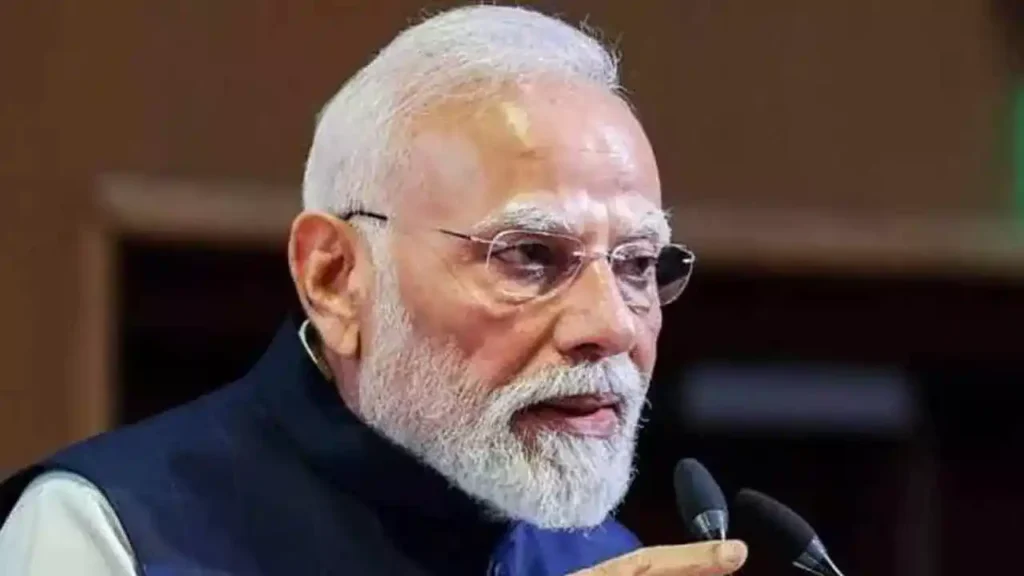New Delhi: In a monumental step toward empowering India’s young population, Prime Minister Narendra Modi has introduced a series of transformative initiatives aimed at enhancing education, vocational training, and job opportunities nationwide. These efforts, totaling more than Rs 62,000 crore in value, underscore the government’s commitment to building a skilled workforce ready for global challenges. At the heart of these announcements is the PM-SETU (Pradhan Mantri Skilling and Employability Transformation through Upgraded ITIs) program, designed to modernize industrial training institutes and align them with industry needs. With a special emphasis on states like Bihar, these schemes promise to create pathways for millions of youth to achieve self-reliance and economic growth.
The event, held on October 4, 2025, at Vigyan Bhawan in New Delhi, marked the fourth edition of the Kaushal Deekshant Samaroh, a national convocation celebrating skill development achievements. During the ceremony, the Prime Minister felicitated 46 top-performing students from Industrial Training Institutes (ITIs) under the Ministry of Skill Development and Entrepreneurship. This gathering not only highlighted individual successes but also served as a platform to launch ambitious projects that integrate education with practical skills, fostering innovation and entrepreneurship.

Understanding PM-SETU: A Rs 60,000 Crore Investment in Vocational Training
The flagship PM-SETU initiative, implemented under the Ministry of Skill Development and Entrepreneurship, represents a Rs 60,000 crore centrally sponsored scheme. Its primary objective is to overhaul 1,000 government-operated ITIs across the nation, converting them into cutting-edge facilities that meet contemporary industry standards. This transformation adopts a hub-and-spoke framework, where 200 hub ITIs will connect with 800 spoke ITIs, forming efficient clusters for broader reach and impact.
Each hub ITI will feature state-of-the-art infrastructure, including innovation and incubation centers, production units, facilities for training trainers, and dedicated placement services. The spoke ITIs, in turn, will prioritize expanding access to training in underserved areas. Key elements of PM-SETU include the introduction of new, market-responsive courses developed in partnership with industries, alongside updates to existing programs. Special Purpose Vehicles (SPVs) will be established with reliable Anchor Industry Partners to oversee these clusters, emphasizing results-oriented training.
Additionally, the scheme will facilitate diverse educational pathways, such as long-term diplomas, short-duration courses, and executive-level programs. To elevate national standards, five National Skill Training Institutes—in Bhubaneswar (Odisha), Chennai (Tamil Nadu), Hyderabad (Telangana), Kanpur (Uttar Pradesh), and Ludhiana (Punjab)—will be fortified as Centres of Excellence through international collaborations.
This government-owned but industry-managed model will receive global financial backing from institutions like the World Bank and Asian Development Bank. In its initial rollout, particular attention will be given to ITIs in Patna and Darbhanga, Bihar, setting a precedent for regional development. By upgrading equipment with modern machinery and incorporating digital learning tools, PM-SETU aims to bridge the gap between India’s youth and worldwide skill requirements, ultimately benefiting over 1,000 ITIs and positioning them as pillars of an Aatmanirbhar (self-reliant) Bharat.
The Legacy and Current Landscape of ITIs in India
Industrial Training Institutes have long been the cornerstone of Vocational Education and Training (VET) in India, dating back to the 1950s. Managed primarily by state governments, these institutions are accredited by the Directorate General of Training (DGT), the premier body for VET under the Ministry of Skill Development and Entrepreneurship. Today, approximately 15,034 ITIs are operational, with 78% being privately owned.
Supporting these ITIs are various government schemes, including Skills Strengthening for Industrial Value Enhancement (STRIVE), the Model ITI program, and Enhancing Skill Development Infrastructure in North Eastern States (ESDI). These efforts have historically aimed to improve quality and accessibility, and PM-SETU builds upon this foundation to create a more dynamic, industry-aligned ecosystem.
Spotlight on Bihar: Tailored Initiatives for Youth Skilling and Education
A significant portion of the October 4 announcements focused on Bihar, recognizing its youthful demographics and historical contributions to India’s progress. The Prime Minister launched the revamped Mukhyamantri Nishchay Svyam Sahayata Bhatta Yojana, which will offer a monthly stipend of Rs 1,000 for two years to nearly five lakh graduate youth annually, complemented by complimentary skill training. This program is designed to support young people in their transition to employment or further education.
In parallel, the redesigned Bihar Student Credit Card Scheme was introduced, providing entirely interest-free loans up to Rs 4 lakh to alleviate the costs of higher studies. To date, over 3.92 lakh students have benefited from loans exceeding Rs 7,880 crore under this initiative.
Further bolstering Bihar’s youth framework, the Prime Minister inaugurated the Bihar Yuva Ayog, a statutory body for individuals aged 18 to 45, aimed at mobilizing and directing the state’s young energy toward productive endeavors. He also officially opened the Jan Nayak Karpoori Thakur Skill University, dedicated to delivering industry-focused courses and vocational training to cultivate a workforce competitive on the global stage.
Advancing higher education infrastructure, foundation stones were laid for new academic and research facilities at four Bihar universities: Patna University, Bhupendra Narayan Mandal University in Madhepura, Jai Prakash Vishwavidyalaya in Chapra, and Nalanda Open University in Patna. Funded under the PM-USHA (Pradhan Mantri Uchchatar Shiksha Abhiyan) with Rs 160 crore, these developments will include modern classrooms, advanced labs, hostels, and multidisciplinary programs, impacting more than 27,000 students.
The dedication of the Bihta campus of NIT Patna was another highlight, with capacity for 6,500 students. This facility boasts cutting-edge amenities like a 5G use case lab, a Regional Academic Centre for Space in partnership with ISRO, and an Innovation and Incubation Centre that has already nurtured nine startups.
Additionally, over 4,000 appointment letters were distributed to new recruits in the Bihar government, and Rs 450 crore in scholarships were transferred via Direct Benefit Transfer to 25 lakh students in Classes 9 and 10 under the Mukhyamantri Balak/Balika Scholarship Scheme.
Nationwide Vocational Enhancements: Skill Labs and Convocation Highlights
Beyond Bihar, the Prime Minister inaugurated 1,200 Vocational Skill Labs in 400 Navodaya Vidyalayas and 200 Eklavya Model Residential Schools spanning 34 states and Union Territories. These labs will provide practical training in 12 priority sectors, including IT, automotive, agriculture, electronics, logistics, and tourism. Aligned with the National Education Policy 2020 and CBSE guidelines, the project includes training for 1,200 vocational educators to ensure high-quality, industry-relevant instruction, particularly in remote and tribal regions.
At the Kaushal Deekshant Samaroh, the Prime Minister emphasized the role of skills in nation-building, stating that his administration is equipping the Yuva Shakti (youth power) to drive India’s future through focused skilling and innovation. He described India as a hub of knowledge and intellectual prowess, with ITIs serving as essential workshops for self-reliance.
Reflecting on Bharat Ratna Karpoori Thakur’s legacy of social service and advocacy for the underprivileged, Mr. Modi noted that the new skill university in his name will advance that mission. He also referenced the ongoing GST Bachat Utsav, highlighting it as a “double bonus” for Bihar’s youth amid recent GST reductions.
Union Minister for Skill Development and Entrepreneurship Jayant Chaudhary echoed the Prime Minister’s goal of establishing India as a global skilling hub. Bihar Chief Minister Nitish Kumar, joining virtually alongside Deputy Chief Minister Samrat Choudhary, praised the central government’s approval of 19 new Kendriya Vidyalayas in Bihar, affirming that these measures will greatly benefit the state’s young population.
Political Context and Critiques: Reflections on Bihar’s Progress
In his address, the Prime Minister critiqued past administrations, particularly the Rashtriya Janata Dal (RJD) era under Lalu Prasad, likening Bihar’s condition then to a “rotten tree.” He highlighted how inadequate education systems led to mass migration, with lakhs of residents fleeing to cities like Banaras, Delhi, and Mumbai for jobs. Mr. Modi accused the RJD of failing to open schools or conduct recruitments earnestly, resulting in a devastated education landscape that younger generations might not fully comprehend.
Praising the Nitish Kumar-led NDA government, he credited it with restoring order and propelling Bihar forward. The naming of the skill university after Karpoori Thakur was lauded as a fitting tribute to his dedication to education and upliftment of backward classes.
Taking a subtle jab at Congress leader Rahul Gandhi—often called ‘Jan Nayak’ by allies—the Prime Minister urged Bihar’s people to guard against attempts to “steal” Thakur’s honorific, earned through genuine public affection rather than social media. This referenced comments by Samajwadi Party chief Akhilesh Yadav during a Bihar visit, where he dubbed Rahul Gandhi and Tejashwi Yadav as Jan Nayaks.
Mr. Modi commended the Bihar government’s pledge to double employment opportunities in the next five years compared to the past two decades, viewing it as a assurance for a prosperous future. Both central and state governments, he said, are collaboratively modernizing Bihar’s educational institutions.
Chief Minister Kumar reinforced this, noting that pre-2005 governments achieved little, leaving Bihar in dire straits, and expressed gratitude for the new initiatives.
Broader Impact: Fostering National Growth Through Youth Empowerment
These launches are poised to generate substantial opportunities by merging education, skills, entrepreneurship, and infrastructure. With Bihar emerging as a skilling powerhouse, the initiatives will contribute to regional and national advancement. By addressing migration through local job creation and training, they align with broader goals of equitable development.
In summary, PM Modi’s youth-centric programs, including PM-SETU and Bihar-specific schemes, represent a strategic investment in India’s future. As the nation advances toward becoming a knowledge economy, these efforts will empower millions, ensuring inclusive growth and global competitiveness.
FAQs
1. What is the PM-SETU scheme, and what is its main objective?
The PM-SETU (Pradhan Mantri Skilling and Employability Transformation through Upgraded ITIs) is a Rs 60,000 crore centrally sponsored scheme launched by Prime Minister Narendra Modi on October 4, 2025. Its primary goal is to modernize 1,000 government Industrial Training Institutes (ITIs) across India into advanced, industry-aligned training hubs. By adopting a hub-and-spoke model (200 hub ITIs linked to 800 spoke ITIs), it aims to equip youth with market-relevant skills, introduce new courses, and enhance infrastructure with innovation centers, production units, and placement services, ensuring global competitiveness.
2. How does the hub-and-spoke model work in the PM-SETU scheme?
The hub-and-spoke model under PM-SETU connects 200 hub ITIs with 800 spoke ITIs to form efficient training clusters. Hub ITIs will feature cutting-edge facilities like digital learning systems, innovation and incubation centers, training-of-trainer facilities, and placement services. Spoke ITIs will focus on expanding access to training, particularly in underserved areas. On average, each hub will connect to four spokes, managed by Special Purpose Vehicles (SPVs) with Anchor Industry Partners to ensure industry-driven, outcome-based skilling.
3. What specific initiatives were launched for Bihar’s youth during the October 4, 2025, event?
In Bihar, PM Modi launched several youth-centric programs, including:
Infrastructure Projects: Foundation stones for academic and research facilities at four universities (Patna University, Bhupendra Narayan Mandal University, Jai Prakash Vishwavidyalaya, and Nalanda Open University) under PM-USHA, and the dedication of NIT Patna’s Bihta campus.
Mukhyamantri Nishchay Svyam Sahayata Bhatta Yojana: Offers Rs 1,000 monthly for two years to five lakh graduates annually, plus free skill training.
Bihar Student Credit Card Scheme: Provides interest-free education loans up to Rs 4 lakh, benefiting over 3.92 lakh students with loans worth Rs 7,880 crore.
Bihar Yuva Ayog: A statutory body for ages 18–45 to channel youth energy.
Jan Nayak Karpoori Thakur Skill University: Focuses on industry-oriented courses and vocational training.
4. What are Vocational Skill Labs, and how do they benefit students?
The Prime Minister inaugurated 1,200 Vocational Skill Labs in 400 Navodaya Vidyalayas and 200 Eklavya Model Residential Schools across 34 states and Union Territories. These labs provide hands-on training in 12 high-demand sectors, such as IT, automotive, agriculture, electronics, logistics, and tourism. Aligned with the National Education Policy 2020 and CBSE curriculum, they include training for 1,200 vocational teachers to deliver industry-relevant education, enhancing employability, especially for students in remote and tribal areas.
5. How do these initiatives contribute to India’s national development?
The initiatives, valued at over Rs 62,000 crore, integrate education, skill development, and entrepreneurship to empower India’s youth. By upgrading ITIs, establishing skill labs, and supporting higher education infrastructure, they create a skilled, globally competitive workforce. In Bihar, schemes like scholarships, loans, and the skill university address migration by fostering local opportunities. Supported by global partners like the World Bank and Asian Development Bank, these programs strengthen India’s position as a knowledge economy, driving regional and national growth.

